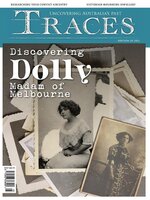This magazine is for people passionate about Australia and New Zealand's genealogy, history and heritage. Whether you want to explore convict history, find your Anzac, identify photographs or trace your family tree, our trusted expert advice will help you discover your past.
Welcome to the 22nd edition of Traces!
Traces
Heritage News
Observatory House, Adelaide • Adelaide’s Observatory House is a decadent display of the design trends that dominated architecture at the turn of the 20th century.
SAVE up to $32.40 when you subscribe!
Everywhen: a new way of thinking about history • ‘Everywhen’ is the Indigenous notion of time in which the past, the present and the future exist as one. Understanding the concept of everywhen can help all historians to think differently about the past, and expand their historical practice into deep history.
Waverley Cemetery • In Australia, attitudes towards cemeteries and burials are drastically different today than they were in the early years following colonisation. At first, cemeteries were just a requirement to maintain society in towns and cities. Graveyards were considered ‘taboo’, and were situated far from city centres due to fears surrounding contamination and sickness from the dead. This meant that graveyards were not places of memorial or remembrance until much later.
FITZROY’S HAND OF GLORY • On 25 January 1875, Melbourne’s newspapers were abuzz with a grisly discovery in the slums of Fitzroy North: a ‘Hand of Glory’.
Master mariner: Captain Jean Benaud • Maurie Garland introduces us to Captain Jean Benaud, who received high praise for his intrepid and noble conduct on New South Wales waters.
‘SO LONG, LETTY’ • In 1917, an Australian troopship sank without a single soul lost.
Embarking on troopship research
Jobs of the streets • The streets of early Melbourne offered something for every taste – cool drinks and ice cream in summer, saveloys (sausages) in winter, and popcorn and biscuits outside the city’s gardens. A curious public, however, was offered plenty of more unusual ways in which to part with their coins.
Street jobs in art
Convict orphans hiding in family trees • Hidden within thousands of Australian family trees are the stories of convict orphans. Between 1828 and 1879, 6000 children were confined within the Queen’s Orphan Schools on the edge of Hobart Town. Today, their descendants are spread throughout Australia and New Zealand.
Research tips: Is a convict orphan hiding in your family tree?
Using case files for your research • Every year on 1 January, hundreds of Victorian state archival records are made public for the first time as part of Public Record Office Victoria’s annual Section 9 openings. Among the files this year was one marked ‘E. R. Ridgway Capital Case’ of 1947.
Percy Cowan: light in dark hours • In May 1926, Percy James Bevin Cowan – a violinist, entertainer and friend of the poet Henry Lawson – lay in a tent in the bush on the Manly Harbour foreshore with a fever and uncontrolled coughing. Boatbuilder James Verrall had granted permission for the slightly built, pale man to camp near his boatshed, hidden from the views of seaside residents.
What’s that thingamajig? • Answer: a rope plaiting machine
Hunter Valley ancestors • Most of my ancestors came from Britain and made their homes in the Hunter Valley, where their lives moved in surprising directions.
A link to ancestors • We asked you, our readers, to share your favourite family heirlooms and the stories they hold.
THE SPANISH SWINDLE • In 1874, various businesses in Scotland received an unusual letter. Stamped with a Spanish postmark, they were sent from prisons in cities such as Madrid, Barcelona and Cartagena. This was the beginning of...

 Edition 29, 2024
Edition 29, 2024
 Edition 28, 2024
Edition 28, 2024
 Edition 27, 2024
Edition 27, 2024
 Edition 26, 2024
Edition 26, 2024
 Edition 25, 2023
Edition 25, 2023
 Edition 24, 2023
Edition 24, 2023
 Edition 23, 2023
Edition 23, 2023
 Edition 22, 2023
Edition 22, 2023
 Edition 21, 2022
Edition 21, 2022
 Edition 20, 2022
Edition 20, 2022
 Edition 19, 2022
Edition 19, 2022
 Edition 18, 2022
Edition 18, 2022
 Edition 17, 2021
Edition 17, 2021
